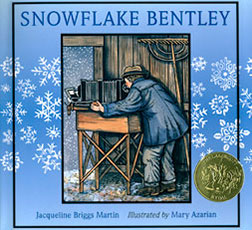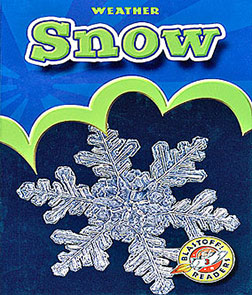Journey
Topic: Earth and Sky
Wintertime
1


Watch the Story
Snowflake Bentley from the book by Jacqueline Briggs Martin
Read the Book
Weather: Snow
2
When Water Freezes
Water can turn from a liquid to a solid if the temperature is just right!Lesson Activities
3

Poetry Activity
Make an Icy Acrostic
Materials: paper and pencil
Optional: stickers, glitter, and glue
Materials: paper and pencil
Optional: stickers, glitter, and glue
It’s time to write a winter-themed acrostic poem! An acrostic is a poem in which the first letters of each line spell out a word.
First, your child will pick a word associated with snow and ice for their acrostic. Here are some suggestions: ice, snow, snowman, snowflake, frozen, blizzard, winter.
Have your child write the word down vertically. For example:
S
N
O
W
Get creative making these letters! Try drawing bubble letters . . . or writing them with marker or paint.
Then brainstorm with your child. What does the word make them think about?
Now write each line of the poem. In our “snow” example, the first line of the poem should start with a word that begins with “S” and so on.
When your child is done, he or she can decorate the poem with drawings or stickers. If you have glitter, add that to create an “icy” effect!
Actividad de poesía
Crea un acróstico de hielo
Materiales: lápiz y papel
Opcional: pegatinas, purpurina y pegamento
Materiales: lápiz y papel
Opcional: pegatinas, purpurina y pegamento
¡Es hora de escribir un poema acróstico de invierno! Un poema acróstico es aquel en que las primeras letras de cada verso forman una palabra.
Primero, los niños escogerán una palabra relacionada con la nieve o el hielo para su acróstico. He aquí algunas sugerencias: hielo, nieve, copo de nieve, frío, invierno.
Pídele a tu niño que escriba la palabra en vertical. Por ejemplo:
N
I
E
V
E
¡Utilicen su talento creativo para escribir estas letras! Pueden tratar con letras en forma de burbujas, dibujarlas con marcadores o pintura.
Luego discute varias ideas con tu niño. ¿Qué les viene a la mente cuando piensan en esta palabra?
Ahora, escriban los versos del poema. En el ejemplo que dimos, “nieve”, el primer verso del poema debería comenzar con una palabra que comienza con “N”. Y así por el estilo.
Una vez terminado, pueden decorar el poema con dibujos o pegatinas. Si tienen purpurina, pueden echarla por encima para darle un aspecto invernal.


